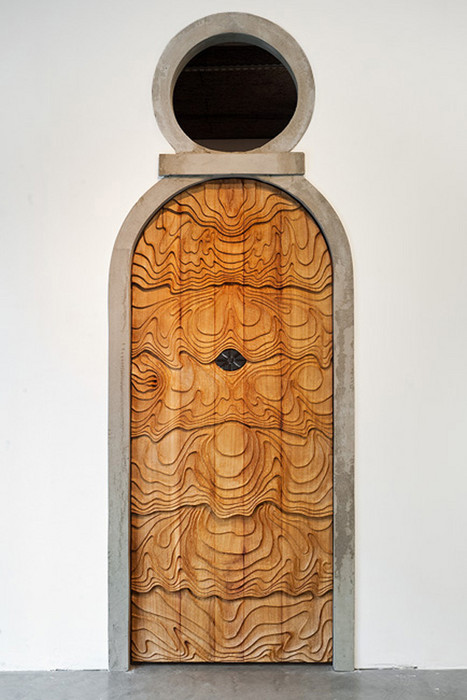Corey McCorkle
19 Feb - 19 Mar 2011
COREY MCCORKLE
19 February - 19 March, 2011
Maccarone is proud to announce its third exhibition of NY-based artist Corey McCorkle. Integrating film and sculpture, McCorkle continues to explore the way in which landscape is articulated and ritualized through marginal or uninhabited spaces, here specifically through the architectural folly.
The Desert de Retz is an immense 18th century garden on the edge of the Forest of Marly. Devised by Francois Racine de Monville, a French aristocrat and inspired designer, the Desert's scheme includes 10 derelict structures, the survivors of a sophisticated park that initially held up to 20 pavilions before its close after The French Revolution. These constructed ruins were designed as a sensual alternative to the prevailing sentiment of rococo Rationalism. A provocative response to the nearby garden of Ermenonville (a pastoral dedication to philosopher Rousseau evoking an austere morality), the Desert was constructed for leisure and "role-playing" evidenced by a preoccupation with the fantastic-grottos, Bedouin tin tents, and Gothic priories built for solely imaginary purposes. Closed and privately owned since 1879, it has been the sight of a Situationist burial and a secret antiwar society led by George Bataille, remaining a place of eccentric and unresolved practices.
This exhibition includes Zoetrope (2010), a five-channel projection of still and tracking shots produced within the Desert's eerie Broken Column. Executed in elliptical and circular movements, the procession through the cavernous highly symbolic structure suggests the archaic Zoetrope, here as an out-of-scale artifact, a storytelling device, and a direct antecedent of film. Through a non-linear approach McCorkle uses the column as a cinematic toy, animating minor events-exalting incomplete memories through different seasons.
Also featured is the sculptural installation Porte Belge, another relic - a Belgian doorway, newly contextualized as a fragment of Nouveau Medievalism. Discovered on a walk (as-in a derive), this overwhelmingly decorative object is reconstructed here as an other-worldly portal. As with the Broken Column, an emblem of the crypto-architectural genre, Porte Belge expresses McCorkle's intrinsic response to grotesque monstrosities, especially those based on longing: Dr. Frankenstein's tragic monster, Milton's neurotic Satan come to mind. Completing the exhibition is a display of intricate bottles McCorkle employed in the gardens of Ireland's Lismore Castle. Distilling his own wine from harvested dandelions picked among the castle grounds, the remaining display consists of 30 reconstituted Bordeaux wine vessels, disparate fragments brought together in a kind of "Exquisite Corpse". Continuing the theme of creation by way of decomposition, the dandelion weeds represent unbridled nature, an irrepressible constant in even the most manicured garden.
The work of Corey McCorkle has been included in numerous institutions around the world including: The Pompidou Center, The Louisiana Museum, KW Berlin, and The Whitney Museum of American Art. Recently work was presented at the MuHKA Antwerp, ArtPace San Antonio, the Frac Ile de France and currently at Frac Lorraine.
19 February - 19 March, 2011
Maccarone is proud to announce its third exhibition of NY-based artist Corey McCorkle. Integrating film and sculpture, McCorkle continues to explore the way in which landscape is articulated and ritualized through marginal or uninhabited spaces, here specifically through the architectural folly.
The Desert de Retz is an immense 18th century garden on the edge of the Forest of Marly. Devised by Francois Racine de Monville, a French aristocrat and inspired designer, the Desert's scheme includes 10 derelict structures, the survivors of a sophisticated park that initially held up to 20 pavilions before its close after The French Revolution. These constructed ruins were designed as a sensual alternative to the prevailing sentiment of rococo Rationalism. A provocative response to the nearby garden of Ermenonville (a pastoral dedication to philosopher Rousseau evoking an austere morality), the Desert was constructed for leisure and "role-playing" evidenced by a preoccupation with the fantastic-grottos, Bedouin tin tents, and Gothic priories built for solely imaginary purposes. Closed and privately owned since 1879, it has been the sight of a Situationist burial and a secret antiwar society led by George Bataille, remaining a place of eccentric and unresolved practices.
This exhibition includes Zoetrope (2010), a five-channel projection of still and tracking shots produced within the Desert's eerie Broken Column. Executed in elliptical and circular movements, the procession through the cavernous highly symbolic structure suggests the archaic Zoetrope, here as an out-of-scale artifact, a storytelling device, and a direct antecedent of film. Through a non-linear approach McCorkle uses the column as a cinematic toy, animating minor events-exalting incomplete memories through different seasons.
Also featured is the sculptural installation Porte Belge, another relic - a Belgian doorway, newly contextualized as a fragment of Nouveau Medievalism. Discovered on a walk (as-in a derive), this overwhelmingly decorative object is reconstructed here as an other-worldly portal. As with the Broken Column, an emblem of the crypto-architectural genre, Porte Belge expresses McCorkle's intrinsic response to grotesque monstrosities, especially those based on longing: Dr. Frankenstein's tragic monster, Milton's neurotic Satan come to mind. Completing the exhibition is a display of intricate bottles McCorkle employed in the gardens of Ireland's Lismore Castle. Distilling his own wine from harvested dandelions picked among the castle grounds, the remaining display consists of 30 reconstituted Bordeaux wine vessels, disparate fragments brought together in a kind of "Exquisite Corpse". Continuing the theme of creation by way of decomposition, the dandelion weeds represent unbridled nature, an irrepressible constant in even the most manicured garden.
The work of Corey McCorkle has been included in numerous institutions around the world including: The Pompidou Center, The Louisiana Museum, KW Berlin, and The Whitney Museum of American Art. Recently work was presented at the MuHKA Antwerp, ArtPace San Antonio, the Frac Ile de France and currently at Frac Lorraine.

